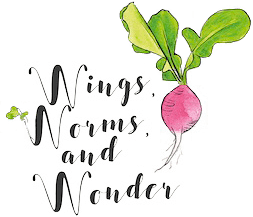Wonder Wednesday 54: Chickweed Salve & Label!
Early spring is just around the corner and that means that chickweed is about to burst in most temperate areas – if it hasn’t already! Down here it’s been going strong all winter!
You may remember me touting the wonders of this plant in the Cheer for Chickweed post from a while back. This wild edible (aka edible weed) is super nutritious, grows abundantly, is enjoyed as a tender green the world over, and I’ve now learned is great for the skin when used topically!
Chickweed’s traditional skin benefits include:
Emollient properties
Cooling and drying effects
Astringent properties
Soothes minor burns
Soothes acne, eczema, psoriasis, & gout
Helps wounds heal
This year, to celebrate this pretty little plant, we’re making a hand salve. Since the spring gardening rush is upon us, or coming soon for you more northern friends, let’s keep our hands healthy while we prepare for a growing season of healthy veggies! (Southern hemisphere friends, if you live in cooler climes you may have chickweed now, so make some salve to use on dry winter hands.)
This recipe is great to make with kids because it’s a solar infusion. + if you have plenty chickweed in your school gardens you could even make this as a mother’s day gift! I even made you a printable label for your jars!
Wonder Wednesday 54: Chickweed Salve
Materials:
Freshly harvested chickweed (Stellaria media) – make sure you are 100% confident in your identification of the plant.
Oil – this could be olive oil, coconut, or even a cocoa. Any oil that firms up in the fridge or at room temperature will work great
Clear glass jar(s) with lid(s). You can do individual small jars (like I did) or you can make 1 big batch and section it out later.
Strainer cloth or bag, cheese cloth, or fine metal strainer
The sun!
Optional: Printed labels and washi tape to decorate your jar/s

Preparation:
What is a salve anyway? It’s an oil based ointment that is often infused with herbs and used for topical healing. Salves are great for dry skin, skin cracks, helping prevent stretch marks, winter hands, and some rashes or bites.
Make sure your jar is clean and dry.
If your oil isn’t liquid when you prepare the salve, warm it on the stove in a double boiler or in the sun so it can be poured.

At some point during the 2-4 weeks, print and cut the label(s) for your jar(s). Print at 100% scale on sticker paper or attach regular paper, whichever you like! (You may want to pop the pdf into your fave program and add more to a page to save paper.) Download your label to print here: wings-worms-and-wonder-chickweed-salve-label

Procedure:
Harvest a bunch of fresh chickweed from your garden, wash off any dirt, and dry very thoroughly. Normally when making a salve you would dry your herb, but chickweed is a special case. It is fragile, dries to straw, and doesn’t retain many of it’s properties in the drying process, so it is used fresh. (Always be 100% positive you can identify wild plants before harvesting for human use.)
You can chop or tear any large pieces of chickweed if you like, or just chop because you (or the children) like to chop!
Place the chickweed into your jar. Pack the jar as full, or not, as you like, or as your chickweed and oil supplies delegate.
Pour the oil over the chickweed, fully submerging it in the oil. Plant material should be immersed in the oil. This seals in the plant and prevents mold and gross things from happening. If a couple tiny pieces are poking up watch them a couple days to make sure they immerse. if they don’t open it up and with a clean utensil push them down under the oil.
Put the lid on tightly.

Place the jar in the bright sun and leave for 2-4 weeks. I left mine 2 weeks. If you have a very bright southern exposure window, you could even place the jar there or outside, but bring it in if it’s cold. You want it to get as much sun as possible. Some herbalists say that the sun’s energy extracts healing elements from the plant not accessible when using the cooking method.
After 2-4 weeks of patience, remove the jar from the sun and strain the herbs from the oil. Be sure to get all little bits of plant material form the oil.

Enjoy:
Let the (herb free) oil firm up at room temperature or in the fridge depending on what type of oil you chose. Once firm, smooth, and creamy, apply to your skin and soak in the gentle healing properties of chickweed!
Add the label if you like – make sure the outside of the jar is clean so it sticks well. You can also wrap washi tape around the lid to make it pretty too if you like.
(**disclaimer – individuals with exceptionally allergy sensitive skin, and unfamiliar with chickweed, should test a small amount first**)
Extensions: Document the process in pictures and words in your nature journal. Explore the botany and ethnobotany of chickweed and try making other recipes for meals or tinctures. Create a little flyer or pamphlet based on your research teaching the cultivation and culture!
Do you have a favorite chickweed recipe?
Share in the comments below!
Share your chickweed salve pics on Instagram #wingswormsandwonder!
Seeds to Sprout:
Learn lots more about chickweed and get a soup recipe using it here!
Download your salve label here: wings-worms-and-wonder-chickweed-salve-label
Learn more about herbal infusions and get another (no solar) salve recipe here!
Learn more about the benefits and uses of chickweed here from the Practical Herbalist – including it’s uses for animals and how it got its common name from feeding baby chicks!
